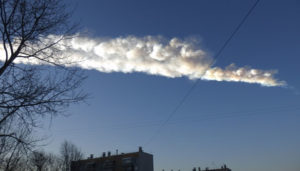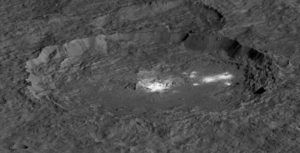Here's a quick look at results announced at the 2017 American Geophysical Union meeting in New Orleans: exploding meteoroids, Saturn's ring-atmosphere connection, and more bright spots on Ceres.

Uragan TT / Wikimedia Commons / CC BY-SA 3.0
Meteoroids Explode from the Inside
Space rocks breaking up in Earth’s atmosphere can be their own Trojan horses. Spurred by an attempt to understand why the 2013 Chelyabinsk meteoroid fragmented so easily, Marshall Tabetah and Jay Melosh (both Purdue University) created a simulation to understand how the rock interacted with the surrounding air as it dove through the atmosphere. The key was the meteoroid’s porosity: asteroids and other space rocks are more like piles of coarse gravel than solid boulders. As one of these rocks shoots through the atmosphere, a bow shock forms around it, with piled-up air in front and a vacuum in the meteoroid’s wake. This setup creates something of a suction effect, with the high-pressure air in front shooting through the rock’s fractures to fill the vacuum behind. The air’s infiltration breaks the meteoroid apart from the inside out. The team’s paper appeared December 11th in Meteoritics & Planetary Science, and you can read more in the press release.
Camille M. Carlisle
Saturn’s Rings Affect Its Atmosphere
Data from the Cassini spacecraft’s Grand Finale orbits indicate that Saturn’s stately rings affect the ionized upper layer of its atmosphere. The atoms and molecules in this layer, called the ionosphere, are stripped of electrons by high-energy radiation from the Sun. It turns out that Saturn’s A and B rings block so much extreme ultraviolet sunlight that the parts of the ionosphere in their shadow are essentially not ionized. The Cassini division between the two rings has a similar, but weaker, effect; the C and D rings do not and so must be transparent to these wavelengths. But these effects cannot explain all of the small-scale variations Cassini detected in the upper atmosphere. Jan-Erik Wahlund (Swedish Institute of Space Physics) and colleagues thus suggest December 11th in Science that some sort of “ring rain” may exist, in which water ions from the rings rain down into the ionosphere, combining with charged particles there to neutralize things. Cassini data don’t show any clear indication of that process.
Camille M. Carlisle

NASA / JPL-Caltech / UCLA / MPS / DLR / IDA
Bright Areas on Ceres Suggest Geological Activity
Scientists have cataloged more than 300 bright areas on the asteoid Ceres, discovered in images returned from the orbiting Dawn spacecraft. The most iconic of these are located in the Occator Crater, but they're far from unique. Nathan Stein and colleagues, publishing in the journal Icarus, listed others found on crater floors, rims, and ejecta, as well as on the likely cryovolcano Ahuna Mons. These bright regions are only as reflective as dirty snow (with albedos as high as about 0.5), but they stand out against the darker background that characterizes Ceres. Previous research has shown that the bright material is made of salts, and these findings provide evidence that impacts brought this material — perhaps stored in an interior ocean — to the surface. To read more about how this could happen, read NASA’s press release.
Monica Young
 1
1









Comments
Peter Wilson
December 15, 2017 at 9:56 am
“Explosion” is a bit of media-spin. If you have ever heard a sonic-boom, you would not say the jet exploded, because after the boom, you can hear the roar of its engines. Large meteoroids produce sonic-booms, too. A rocky one, however, can “fragment," as described in the article. Say it breaks in half. Instantly, its surface-area is doubled, and so is the heating. The extra heating causes further breakup, and more heating, and so-on, causing it to suddenly brighten. At the same time, the extra surface-area works to slow down the many fragments; then their brightness fades. So the meteoroid “breakup” produces a sudden flare in brightness. Several minutes later, people on the ground hear the sonic-boom. The TV talking heads love to gush, “A meteor exploded!” But what the witnesses saw was a breakup, and what they heard was a sonic boom.
You must be logged in to post a comment.
You must be logged in to post a comment.